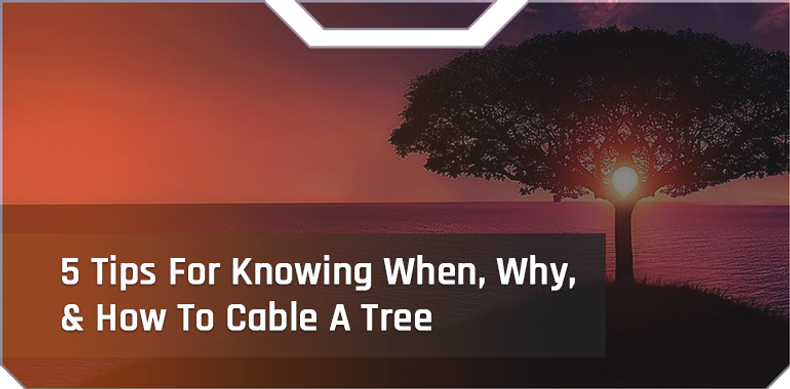Full Guide to Cabling a Tree
For Arborists and other professional Tree Workers, cabling a tree is usually not seen as ideal, but it sometimes can be the best alternative to removing a tree.
The key to responsible cabling is knowing a few things - mostly why you would use this method, when it is the appropriate choice, and how you can do it effectively.
We have put together a list of 5 tips to figure out the answers to these kinds of questions.
Hopefully, after reading this article, you will have a better sense of whether cabling is the right choice for your tree.
1. Know Why You Are Cabling Your Tree
There are some very good reasons to cable a tree. When other options don’t seem to be great choices, a cabling or bracing system can help increase the lifespan of a tree and minimize stress in a tree.
Some Advantages To Cabling A Tree:
- Can Reduce Stress From Ice, Snow, & Wind
- Supporting Strained Or Decayed Branches In A Codominant Stem
- Supporting Weak Branches That Have Grown Out Of Old Wounds In A Tree
This all sounds awesome, right? If it saves the tree or extends its lifetime, then, yes, it is awesome, but there are some drawbacks to consider.
Some Drawbacks To Cabling A Tree:
- Tree Cabling Cannot Fully Eliminate Hazards In Branches
- Any Time That Hardware Is Installed In A Tree, It Will Alter The Way That A Tree Responds To The Wind, Which Can Make Decay Worse
2. Know When When Is When
Since we just talked about some of these significant drawbacks to cabling, you are maybe wondering, “Well, when is a good time?"
One of the most common applications for cabling is strengthening the meeting point of two codominant stems. These are two stems of a very similar size that branch out of the same location in a tree. Since neither stem becomes dominant a tree will naturally sometimes develop decay or form into a weak “V shape.”
Signs That Cabling Is The Right Solution For A Tree:
- The Base Of The Tree Can’t Support The Canopy
- A “Low Lying V” Shape Has Formed In The Base Of A Tree
- Limbs Are Leaning Toward A House And Can’t Be Removed
- A Tree Is Mostly Structurally Sound But Could Benefit From Extra Limb Support
Since we are still dealing with “when” questions, it is also worth noting that cabling should be done after proper pruning has already been applied to the branches of a tree.
3. Know What You Are Going To Use
There are a few different methods of cabling a tree that may call for different types of gear. Here in the U.S., common grade cables are usually used, with alternate methods calling for EHS (Extra High Strength) cables.
On top of that, some sort of drill will be required, along with various forms of hardware.
Gear That May Be Used For Cabling:
- J Lags
- Vice Grip
- Eye Bolts
- Turnbuckles
- Cable Thimbles
- ⅜” or ¼” Common Cables
- A Power Drill Or A Brace & Bit
4. Know How You May Want To Cable Your Tree
As we talked about before, there are a few different methods for cabling. If you are doing an at-home DIY cabling job and looking for a simple solution, you can apply a cable by drilling all the way through two branches. In this scenario, you would put eye-bolts through the holes and fasten them with washers.
The above method may cause more damage to a tree than is necessary. If you are a little more skilled you may want to try installing the cable using a J-Lags and a brace and bit tool. In this case, the J-lags should be installed in an upper position with some space between the bark of the tree and the top end of the hardware.
5. More Things To Know
Whether you are cabling with eye-bolts or J-lags, there are a few more things you should know before you start looking for deeply into how to cable.
Additional Considerations:
- When Possible, Using A Ladder Is Recommended
- Cabling Will Likely Need To Be Adjusted Periodically
- Cabling Is Generally Applied ⅔ Of The Way Up From The Crotch In A Tree
- Trees Will Respond To Wind In Different Ways According To Seasonal Weather
- You May Want To Use A Turnbuckle To Reduce Line Twisting When Tensioning
Terminating This Line
Remember that for most Arborists, cabling or bracing a tree is rarely seen as a first choice. By nature, applying hardware to a tree will cause its own damage to the structure of the tree. In some cases, it may even be preferable to remove a tree.
However, in those cases where cabling is the best option, it is important to look into options that will minimize damage. You will particularly want to minimize restricting a tree from using its natural responses to the wind and weather.
We wish you the best of luck with finding the right solution for your tree!





